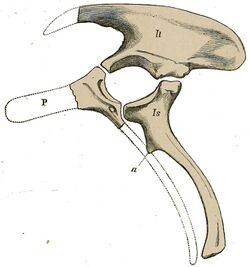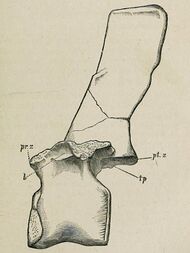Biology:Barilium
| Barilium | |
|---|---|

| |
| Pelvis | |
| Scientific classification | |
| Domain: | Eukaryota |
| Kingdom: | Animalia |
| Phylum: | Chordata |
| Clade: | Dinosauria |
| Clade: | †Ornithischia |
| Clade: | †Ornithopoda |
| Clade: | †Styracosterna |
| Genus: | †Barilium Norman, 2010 |
| Species: | †B. dawsoni
|
| Binomial name | |
| †Barilium dawsoni (Lydekker, 1888 [originally Iguanodon])
| |
| Synonyms | |
| |
Barilium is a genus of iguanodontian dinosaur which was first described as a species of Iguanodon (I. dawsoni) by Richard Lydekker in 1888, the specific epithet honouring the discoverer Charles Dawson, who collected the holotype during the 1880s.[1]

In 2010 it was reclassified as a separate genus by David Norman. The generic name Barilium is derived from Greek barys, "heavy", and Latin ilium.[2] Later in 2010, Kenneth Carpenter and Yusuke Ishida independently assigned it to the new genus Torilion,[3] which is thus a junior objective synonym of Barilium. It is known from two partial skeletons found near St Leonards-on-Sea in East Sussex, England ,[4] from the middle Valanginian-age Lower Cretaceous Wadhurst Clay.[5] Lydekker based the species on the syntype series BMNH R798, 798a, 803-805, 806, 798b, 802, 802a and 799-801. Norman chose NHMUK R 798 and R802, a dorsal vertebra and a left ilium, as the lectotype.
A contemporary of Hypselospinus (also once thought to be a species of Iguanodon), Barilium was a robust iguanodontian estimated at 8 metres (26 feet) long.[6]
Barilium is separated from Hypselospinus on the basis of vertebral and pelvic characters, size, and build.[6] For example, Barilium was more robust than Hypselospinus, with large Camptosaurus-like vertebrae featuring short neural spines, whereas Hypselospinus is known for its "long, narrow, and steeply inclined neural spines".[7]
References
- ↑ Lydekker, Richard (1888). "Note on a new Wealden iguanodont and other dinosaurs". Quarterly Journal of the Geological Society of London 44 (1–4): 46–61. doi:10.1144/GSL.JGS.1888.044.01-04.08. https://zenodo.org/record/2350732.
- ↑ Norman, David B. (2010). "A taxonomy of iguanodontians (Dinosauria: Ornithopoda) from the lower Wealden Group (Cretaceous: Valanginian) of southern England". Zootaxa 2489: 47–66. doi:10.11646/zootaxa.2489.1.3. http://mapress.com/zootaxa/2010/f/z02489p066f.pdf.
- ↑ Carpenter, K. and Ishida, Y. (2010). "Early and “Middle” Cretaceous Iguanodonts in Time and Space.[yes|permanent dead link|dead link}}]" Journal of Iberian Geology, 36 (2): 145-164.
- ↑ Norman, David B. (2004). "Basal Iguanodontia". in Weishampel, D.B.. The Dinosauria (2nd ed.). Berkeley: University of California Press. pp. 413–437. ISBN 978-0-520-24209-8.
- ↑ Paul, Gregory S. (2008). "A revised taxonomy of the iguanodont dinosaur genera and species". Cretaceous Research 29 (2): 192–216. doi:10.1016/j.cretres.2007.04.009. http://doc.rero.ch/record/16134/files/PAL_E2902.pdf.
- ↑ 6.0 6.1 Blows, W. T. (1997). "A review of Lower and middle Cretaceous dinosaurs from England". in Lucas, S.G.. Lower and Middle Cretaceous Terrestrial Ecosystems. New Mexico Museum of Natural History and Science Bulletin, 14. New Mexico Museum of Natural History and Science. pp. 29–38.
- ↑ Naish, Darren; Martill, David M. (2008). "Dinosaurs of Great Britain and the role of the Geological Society of London in their discovery: Ornithischia". Journal of the Geological Society, London 165 (3): 613–623. doi:10.1144/0016-76492007-154. Bibcode: 2008JGSoc.165..613N.
Wikidata ☰ Q1932480 entry
 |

